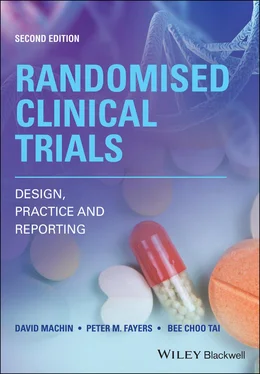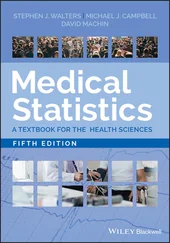It is now more than 10 years since the first edition of this book was published. In the intervening years, while many things have remained unchanged, there have also been many new developments over the period. This second edition refreshes the first, refining some of the sections to better explain their contents and, at the same time, replacing some examples with more current illustrations. To reflect the changes, we have created new chapters by splitting and then expanding old chapters. Thus, we now include full chapters on data and safety monitoring including interim analyses of accumulating data, cluster designs, repeated measures, and noninferiority designs as there has been a rapid increase in the use of such trial designs along with some methodological developments and improvements in statistical software available for analysis. In addition, we have included entirely new chapters on stepped wedge designs, genomic targets and, feasibility and pilot studies. The chapter on stepped wedge designs reflects the growing importance of such complex intervention designs while that on genomic targets highlights the research focus directed towards more individualised medicine. In contrast, the new chapter concerned with feasibility and pilot studies brings us back to the early planning stages of the clinical trial which is planned. The chapter is included as there is increasing recognition that perhaps a more structured approach is required at the planning stage of any proposed trial. The intention is to help avoid the conduct of clinical trials which fail due to the basic assumptions made at the planning stage being inappropriate.
This edition is divided into three sections: I Basic Considerations, II Adaptions of the Basic Design and III Further Topics. As the title suggests, the first section is intended to cover topics that are relevant to all randomised trials of whatever design and complexity. Thus, it may be the key section for those who are new to clinical trials and an aide‐memoire for those more experienced in this area. For this purpose, it concentrates on the parallel two‐group controlled trial with a single outcome measure where patients are randomised individually to one of the two interventions concerned.
The second section expands on the individually randomised design in several ways by considering paired designs, repeated assessments of the (same) outcome measure over time, more than two interventions and non-inferiority trials. It also includes cluster trials, and stepped wedge designs in which groups rather than individuals are randomised to the interventions concerned. The final section deals with genomic targets, feasibility and pilot studies, and a final chapter on miscellaneous topics including adaptive designs, large simple trials and very small trials with new additions describing alpha spending functions and the predictive probability test for use in interim analyses.
We are grateful to many colleagues, collaborators and numerous investigators who have contributed directly or indirectly to this book over many years.
We thank Isaac Koh for the cover design and Leo Liu for his professional advice on this.
David Machin
Peter M. Fayers
Bee Choo Tai
Leicester and Sheffield, Aberdeen, and Singapore
PS
As we read the proofs of this book, under lockdown conditions imposed by Covid-19, results of successful randomised trials with respect to treatments for those who have contracted the disease and protective vaccines against the pandemic have been published. These include the use of dexamethasone as described by The RECOVERY Collaborative Group (2020) and the Pfizer-BioNTech mega-sized vaccine trial against Covid-19 tested by Polack, Thomas, Kitchin, et al . (2020). To overcome the challenges in conducting clinical trials as a result of lockdown and the need to minimise face-to-face contact due to the infectious nature of the coronavirus, the use of e-consent is briefly discussed in Chapter 3.
PART I Basic Considerations
A very large number of clinical trials with human subjects have been conducted in a wide variety of contexts. Many of these have been concerned, for example, with improving (in some way) the management of patients with disease and others the prevention of the disease or condition in the first place. The essence of a clinical trial is the comparison of a standard strategy with an alternative (perhaps novel) intervention. The aim of this chapter is to illustrate some of the wide variety of clinical trials that have been conducted and to highlight some key features of their design, conduct and analysis.
The aim of this book is to introduce those who are to become involved with randomised clinical trials to the wide range of challenges that are faced by those who conduct such trials. Thus, our intended readership is expected to range from healthcare professionals of all disciplines who are concerned with patient care to those more involved with the non‐clinical aspects such as the statistical design, data processing and subsequent analysis of the results. We assume no prior knowledge of clinical trial processes, and we have attempted to explain the more statistical sections in as non‐technical a way as possible. In a first reading of this book, these sections could be omitted. Throughout the book, we stress the collaborative nature of clinical trials activity and would hope that readers would consult their more experienced colleagues on aspects of our coverage.
The business of clinical trials is an ongoing process, and as we write, trials are currently being designed (particularly with respect to the coronavirus), opened, conducted, closed, analysed, reported, results filtered into current practice and the next planned. To describe the key features of this process, it is difficult to know where to start as each stage interacts with each of the others to some extent. For example, in designing a trial the investigators need to be mindful of the eventual analysis to be undertaken as this governs (but it is only one aspect of) how large a trial should be launched. Some of the steps are intellectually challenging, for example, defining the key therapeutic question, whilst others may perhaps appear more mundane, such as defining the data forms or the data entry procedures but all steps (whether large or small: major or minor) underpin the eventual successful outcome – the influence on clinical practice once the trial results are available. For many of these aspects of the process, whole books have been written. We can only provide an introduction to these.
Numerous terms including ‘clinical trial’ itself need to be introduced. As a consequence, we have included a Glossary of Terms, which is mainly extracted from Day (2007) Dictionary of Clinical Trials . Thus, the Glossary defines: clinical trial: any systematic study of the effects of a treatment in human subjects. These definitions may not be exhaustive in the sense, that ‘treatment’ used here may be substituted by, for example, ‘intervention’ depending on the specific context of the clinical trial under consideration.
Clinical trials require a multidisciplinary approach in which all partners play a key role at some stage of the trial process. Furthermore, ‘Evidence‐Based Medicine’ (EBM) requires that it is important to consider critically all the available evidence about whether, for example, a treatment works, before recommending it for clinical practice. In this respect, it is therefore vital that one can clearly see that a proposed trial addresses a key question which will have a clinically meaningful outcome, is well designed, conducted and reported, and the results are persuasive enough to change clinical practice if appropriate.
Читать дальше












